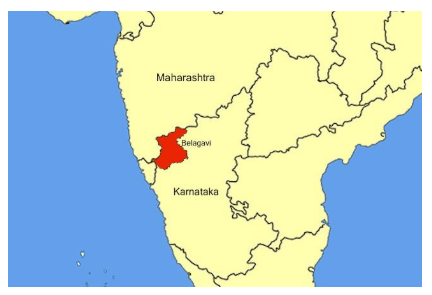UPSC Articles
HISTORY
TOPIC: General Studies 1:
- Post-independence consolidation and reorganization within the country
Inter- state border dispute: Maharashtra-Karnataka Belgaum tension (Part-2)
In news:
- Recently Bus services between Kolhapur and Belgaum were suspended after the decades-old border dispute between Maharashtra and Karnataka flared up again.
- Various Kannada organisations had staged a protest in Belgaum and burnt the effigy of Maharashtra Chief Minister Uddhav Thackeray.
Controversy
- In 1957, slighted by the implementation of the States Reorganisation Act, 1956, Maharashtra demanded readjustment of its border with Karnataka.
- It invoked Section 21 (2) (b) of the Act, and submitted a memorandum to the Ministry of Home Affairs stating its objection to Marathi- speaking areas being added to Karnataka.
- It claimed an area of 2,806 square miles that involved 814 villages, and three urban settlements of Belagavi, Karwar and Nippani with a total population of about 6.7 lakh, all part of the Mumbai Presidency before independence.
- The villages are spread across Belagavi and Uttar Kannada in north-western Karnataka, and Bidar and Gulbarga districts in north-eastern Karnataka — all bordering Maharashtra.
- when a four-member committee was formed by both States, Maharashtra expressed willingness to transfer predominantly Kannada-speaking 260 villages with a population of about 3.25 lakh and total area of 1,160 square miles in lieu of accepting its demand for 814 villages and three urban settlements, which was turned down by Karnataka.

Daily Current Affairs IAS | UPSC Prelims and Mains Exam – 6th January 2020
Remember:
- Karnataka declared Belagavi its second capital, holds its winter session at the newly constructed Vidhan Soudha, changed the name of Belgaum to Belagavi and also held the World Kannada Summit there — all in the last 15 years.
- In 2004, Maharashtra approached the Supreme Court for a settlement under Article 131(b) of the Constitution.
- Karnataka has questioned the suit. With one of the judges recusing, the court has to set up a new bench.
Maharashtra’s claim:
- Maharashtra’s claim to seek the readjustment of its border was on the basis of contiguity, relative linguistic majority and wishes of the people.
- If the claim over Belagavi and surrounding areas was based on Marathi-speaking people and linguistic homogeneity, it laid its claim over Karwar and Supa where Konkani is spoken by citing Konkani as a dialect of Marathi.
- Its argument was based on the theory of village being the unit for calculation and enumerated linguistic population in each village.
- Maharashtra also points out the historical fact that the revenue records in these Marathi-speaking areas are also kept in Marathi.
Karnataka’s position:
- Karnataka has argued that the settlement of boundaries as per the States Reorganisation Act is final.
- The boundary of the State was neither tentative nor flexible.
- The State argues that the issue would reopen border issues that have not been contemplated under the Act, and that such a demand should not be permitted. Initially, Karnataka was open to adjusting the border in the 10 mile belt from the drawn boundary.
- Karnataka also points out that when Congress, which redrew its circles on linguistic basis in 1920, included Belagavi in the Karnataka Provincial Congress Committee. Besides, the States Reorganisation Commission vested Belagavi with Karnataka.
Way forward:
- In 1960, both States agreed to set up a four-man committee with two representatives from each State.
- Except on the issue of contiguity, the committee could not arrive at a unanimous decision, and respective representatives submitted reports to their government.
- Between the 1960s and 1980s, chief ministers of Karnataka and Maharashtra have met several times to find a solution to the vexed issue but with no avail.
Central govt’s stand:
- In 1966, the Centre announced setting up a one-man commission under former Chief Justice of the Supreme Court of India Meher Chand Mahajan to look into border issues between Karnataka (then Mysore state) and Maharashtra.
- The commission was also asked to look into Karnataka’s demand for integration of Kannada-speaking areas in Kasargod in Kerala.
- Karnataka sought areas in Kolhapur, Sholapur and Sangli districts from Maharashtra, and Kasargod from Kerala.
- The commission rejected Maharashtra’s claim over Belagavi city while recommending transfer of about 260 villages in the border to Maharashtra and about 250 villages in Maharashtra to Karnataka.
- Maharashtra said the report was inconsistent and an unfair application of its own principle. It also said the report was not a final word on the issue. Karnataka, however, agreed to the report.
Connecting the dots:
- Do you think this dispute is detrimental for the integrity of the country?
- How do you think the dispute can be resolved?











